
Clintonia is a genus of flowering plants in the lily family Liliaceae. Plants of the genus are distributed across the temperate regions of North America and eastern Asia, in the mesic understory of deciduous or coniferous forests. The genus, first described by Constantine Samuel Rafinesque in 1818, was named for DeWitt Clinton (1769–1828), a naturalist and politician from the U.S. state of New York. For this reason, plants of the genus are commonly known as Clinton's lily. The common name bluebead refer to the distinctive fruit of members of the genus. Since fruit color varies somewhat across species, the common name bead lily is used as well.

Eugenia uniflora, the pitanga, Suriname cherry, Brazilian cherry, Cayenne cherry, cerisier carré, monkimonki kersie,ñangapirí, or shimarucu is a flowering plant in the family Myrtaceae, native to tropical South America’s east coast, ranging from Suriname, French Guiana to southern Brazil, as well as Uruguay and parts of Paraguay and Argentina. It is often used in gardens as a hedge or screen. The tree was introduced to Bermuda for ornamental purposes but is now out of control and listed as an invasive species. The tree has also been introduced to Florida.

Monotropa uniflora, also known as ghost plant, ghost pipe, or Indian pipe, is an herbaceous perennial flowering plant native to temperate regions of Asia, North America, and northern South America, but with large gaps between areas. The plant is waxy white, but some specimens have been described as having black flecks or pale pink coloration. Rare variants may have a deep red color. The name "Monotropa" is Greek for "one turn" and "uniflora" is Latin for "one flowered" as there is one sharply curved stem for each single flower. M.uniflora is commonly found growing in clumps of 2 or more, with its fungal source nearby.

Circaeasteraceae is a family of two species of herbaceous plants native to China and the Himalayas.
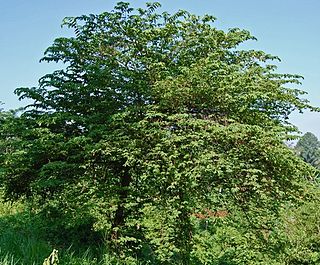
The Muntingiaceae are a family of flowering plants, belonging to the rosid order Malvales. The family consists of three genera: Dicraspidia, Muntingia, and Neotessmannia, each with a single species. They are woody plants of the tropical regions of America. The older Cronquist system placed these genera in the family Tiliaceae, with which they share morphological similarities, but have no evolutionary affinity. Muntingia calabura is widely introduced in tropical regions, because of its edible fruit. Dicraspidia donnell-smithii and Neotessmannia uniflora are the other two species in the family, the latter only known from herbarium specimens.

Moneses uniflora, the one-flowered wintergreen, single delight, wax-flower, shy maiden, star of Bethlehem (Aleutians), St. Olaf's candlestick (Norway), wood nymph, or frog's reading lamp, is a plant of the family of Ericaceae, that is indigenous to moist coniferous forests in temperate regions of the Northern Hemisphere from Spain to Japan and across North America. It is the sole member of genus Moneses.
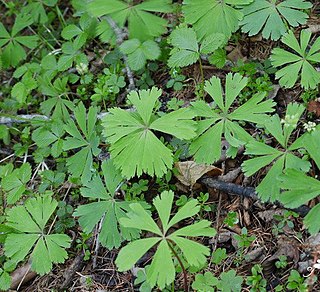
Kingdonia uniflora is a species of perennial herb native to China. The plants have one leaf and a 100-millimetre (4-inch) flower stalk with a 8 mm flower.

Arachnitis uniflora, the sole species in the genus Arachnitis, is a non-photosynthetic plant species in the family Corsiaceae. This species is mycoheterotrophic, and it obtains carbon from mycorrhizal fungi of the family Glomeraceae which are associated to its roots.

Orobanche uniflora, commonly known as one-flowered broomrape, one-flowered cancer root, ghost pipe or naked broomrape, is an annual parasitic herbaceous plant. It is native to much of North America, where it is a parasitic plant, tapping nutrients from many other species of plants, including those in the families Asteraceae and Saxifragaceae and in the genus Sedum. The name "orobanche" can be translated to "vetch-strangler" and "uniflora" can be translated to "single-flower".

Clintonia uniflora, commonly known as bride's bonnet, queen's cup, or bead lily, is a species of flowering plant in the lily family Liliaceae. The specific epithet uniflora means "one-flowered", a characteristic that distinguishes this species from others in the genus Clintonia. For this reason, it is also known as the single-flowered clintonia.
Hancockiidae is a family of sea slugs, nudibranchs, marine gastropod mollusks in the superfamily Tritonioidea.

Campanula uniflora, known commonly as arctic bellflower and arctic harebell, is a short and slender rhizomatous perennial in the bellflower family Campanulaceae. It is distributed in arctic North America, including the Rocky Mountains and Greenland, in the Asian part of Beringia and in Iceland, Svalbard, the Scandes Mountains and Novaja Zemlja.

Centaurea uniflora, the singleflower knapweed, is a perennial herbaceous plant belonging to the genus Centaurea of the family Asteraceae.

Hydrolea is the only genus of the family Hydroleaceae of the order Solanales.
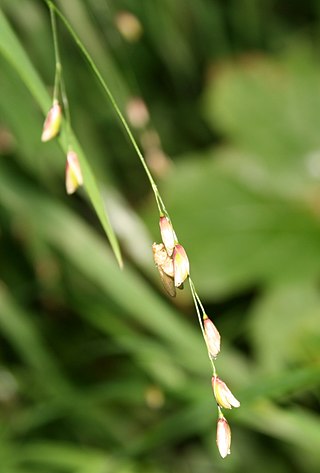
Melica uniflora, commonly known as wood melick, is a species of grass in the family Poaceae that is native to much of Europe, and to parts of South West Asia and North Africa.

Silene uniflora is a species of flowering plant in the family Caryophyllaceae known by the common name sea campion.

Balduina uniflora, commonly called oneflower honeycombhead, savannah honeycombhead or oneflower balduina, is a North American species of plants in the sunflower family. It is native to the southeastern United States. It is the type species of the genus Balduina.
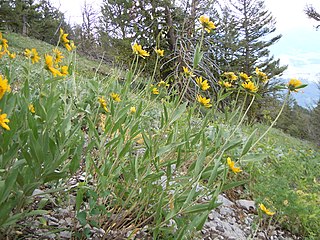
Helianthella uniflora, the oneflower helianthella, is a North American plant species in the family Asteraceae. It grows in the western United States and western Canada. It has been found from British Columbia south as far as northern Arizona and northern New Mexico.

Hancockia californica is a species of sea slug, an Eastern Pacific Ocean nudibranch, a marine, opisthobranch gastropod mollusk in the family Hancockiidae.
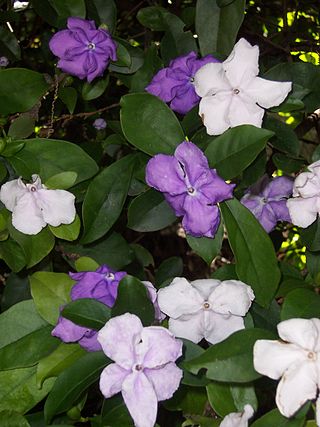
Brunfelsia uniflora, the manac, is a species of flowering plant in the family Solanaceae. It is native to Monos island of Trinidad and Tobago, Venezuela, the Venezuelan Antilles, Guyana, Brazil, and northwest Argentina, and has been introduced to eastern Tropical Africa, Réunion, Mauritius, India, and Assam. A poisonous evergreen shrub typically 0.5 to 3 m tall, it is commonly cultivated as an ornamental, and as an ingredient in ayahuasca and other potions, usually under its synonym Brunfelsia hopeana.


















